Kai Xu
National University of Defense Technology
RayMVSNet: Learning Ray-based 1D Implicit Fields for Accurate Multi-View Stereo
Apr 04, 2022
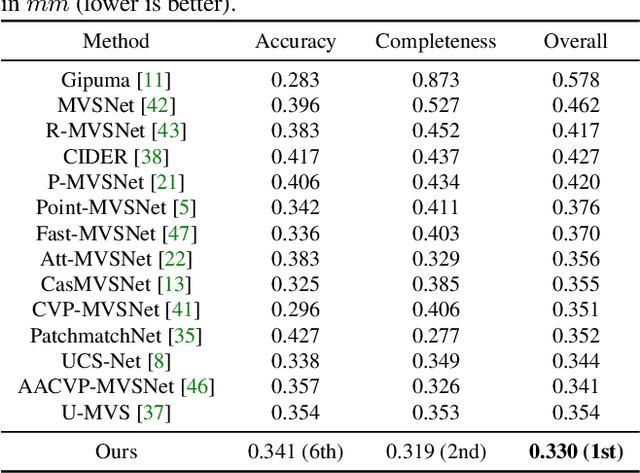
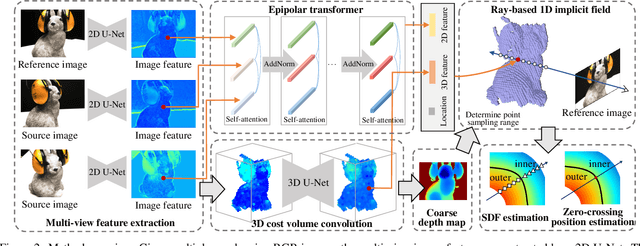

Abstract:Learning-based multi-view stereo (MVS) has by far centered around 3D convolution on cost volumes. Due to the high computation and memory consumption of 3D CNN, the resolution of output depth is often considerably limited. Different from most existing works dedicated to adaptive refinement of cost volumes, we opt to directly optimize the depth value along each camera ray, mimicking the range (depth) finding of a laser scanner. This reduces the MVS problem to ray-based depth optimization which is much more light-weight than full cost volume optimization. In particular, we propose RayMVSNet which learns sequential prediction of a 1D implicit field along each camera ray with the zero-crossing point indicating scene depth. This sequential modeling, conducted based on transformer features, essentially learns the epipolar line search in traditional multi-view stereo. We also devise a multi-task learning for better optimization convergence and depth accuracy. Our method ranks top on both the DTU and the Tanks \& Temples datasets over all previous learning-based methods, achieving overall reconstruction score of 0.33mm on DTU and f-score of 59.48% on Tanks & Temples.
Geometric Transformer for Fast and Robust Point Cloud Registration
Mar 12, 2022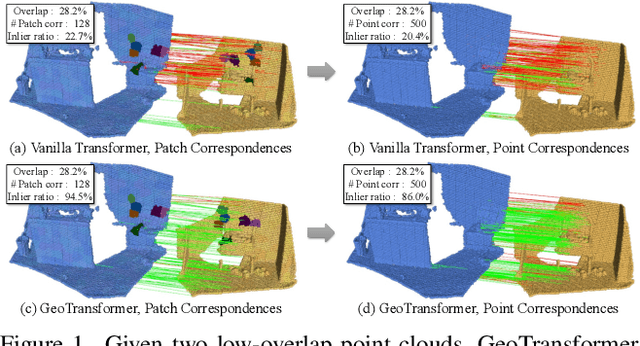
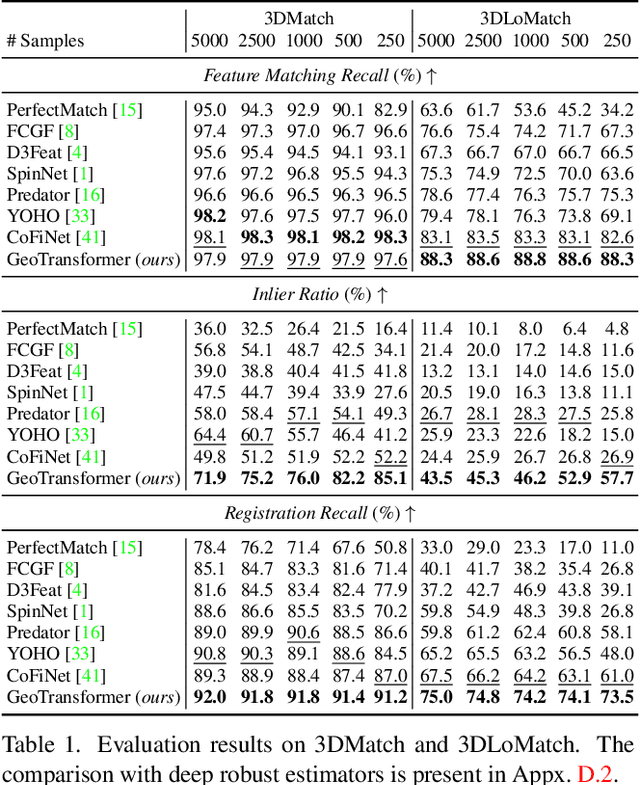
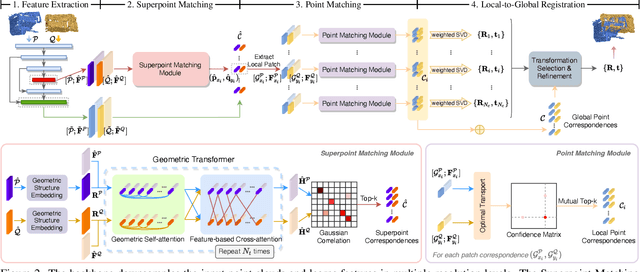
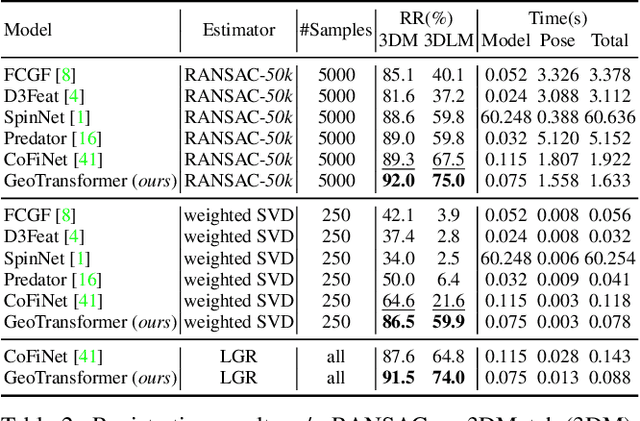
Abstract:We study the problem of extracting accurate correspondences for point cloud registration. Recent keypoint-free methods bypass the detection of repeatable keypoints which is difficult in low-overlap scenarios, showing great potential in registration. They seek correspondences over downsampled superpoints, which are then propagated to dense points. Superpoints are matched based on whether their neighboring patches overlap. Such sparse and loose matching requires contextual features capturing the geometric structure of the point clouds. We propose Geometric Transformer to learn geometric feature for robust superpoint matching. It encodes pair-wise distances and triplet-wise angles, making it robust in low-overlap cases and invariant to rigid transformation. The simplistic design attains surprisingly high matching accuracy such that no RANSAC is required in the estimation of alignment transformation, leading to $100$ times acceleration. Our method improves the inlier ratio by $17{\sim}30$ percentage points and the registration recall by over $7$ points on the challenging 3DLoMatch benchmark. Our code and models are available at \url{https://github.com/qinzheng93/GeoTransformer}.
DisARM: Displacement Aware Relation Module for 3D Detection
Mar 02, 2022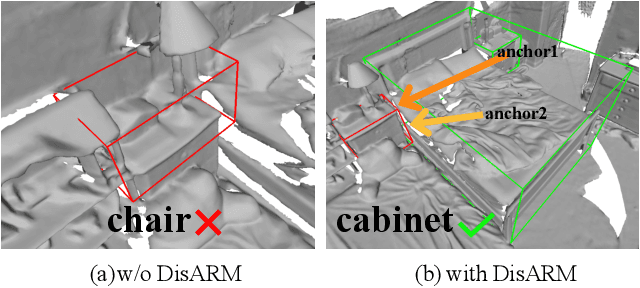
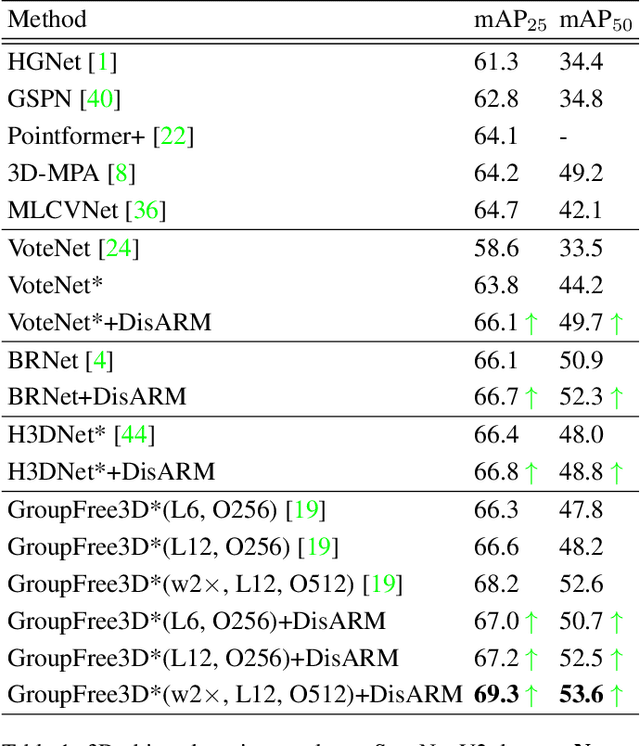
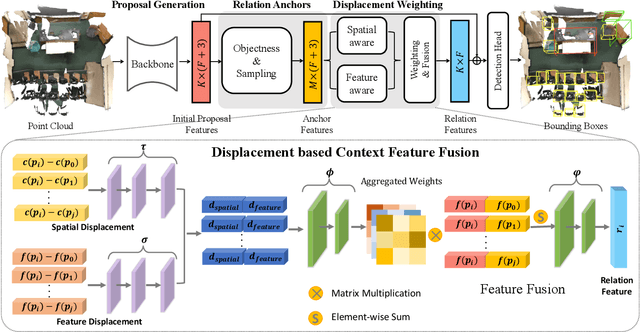

Abstract:We introduce Displacement Aware Relation Module (DisARM), a novel neural network module for enhancing the performance of 3D object detection in point cloud scenes. The core idea of our method is that contextual information is critical to tell the difference when the instance geometry is incomplete or featureless. We find that relations between proposals provide a good representation to describe the context. However, adopting relations between all the object or patch proposals for detection is inefficient, and an imbalanced combination of local and global relations brings extra noise that could mislead the training. Rather than working with all relations, we found that training with relations only between the most representative ones, or anchors, can significantly boost the detection performance. A good anchor should be semantic-aware with no ambiguity and independent with other anchors as well. To find the anchors, we first perform a preliminary relation anchor module with an objectness-aware sampling approach and then devise a displacement-based module for weighing the relation importance for better utilization of contextual information. This lightweight relation module leads to significantly higher accuracy of object instance detection when being plugged into the state-of-the-art detectors. Evaluations on the public benchmarks of real-world scenes show that our method achieves state-of-the-art performance on both SUN RGB-D and ScanNet V2.
DropIT: Dropping Intermediate Tensors for Memory-Efficient DNN Training
Feb 28, 2022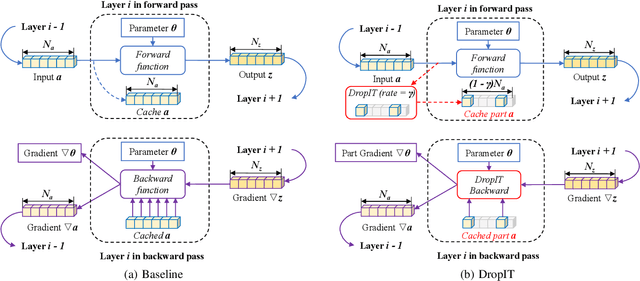

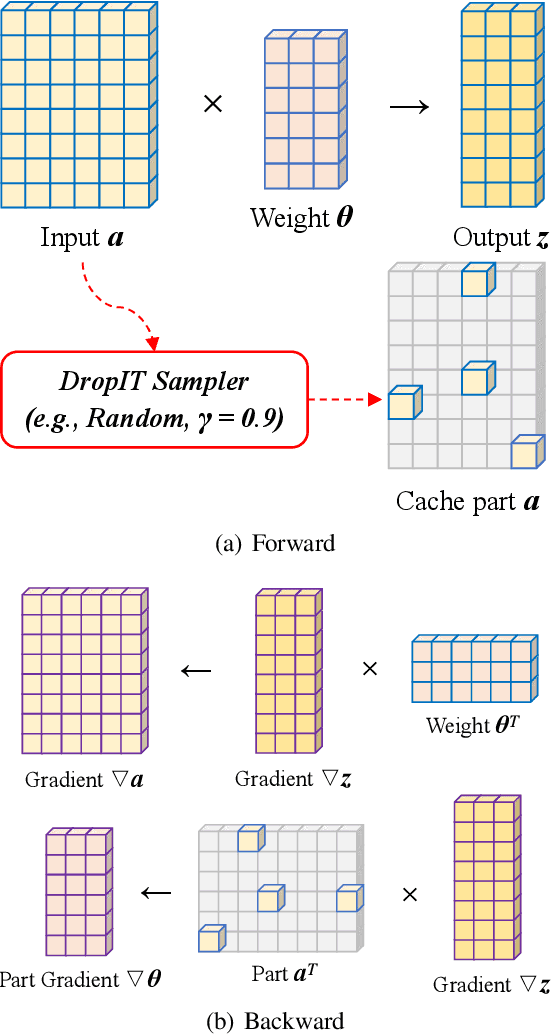
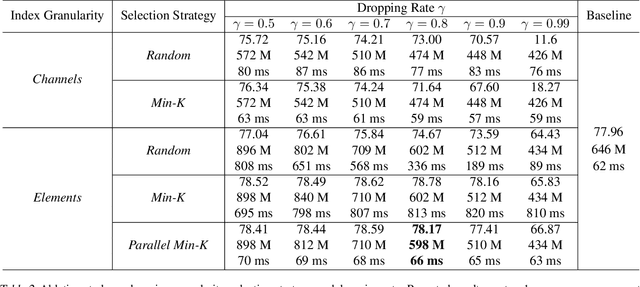
Abstract:A standard hardware bottleneck when training deep neural networks is GPU memory. The bulk of memory is occupied by caching intermediate tensors for gradient computation in the backward pass. We propose a novel method to reduce this footprint by selecting and caching part of intermediate tensors for gradient computation. Our Intermediate Tensor Drop method (DropIT) adaptively drops components of the intermediate tensors and recovers sparsified tensors from the remaining elements in the backward pass to compute the gradient. Experiments show that we can drop up to 90% of the elements of the intermediate tensors in convolutional and fully-connected layers, saving 20% GPU memory during training while achieving higher test accuracy for standard backbones such as ResNet and Vision Transformer. Our code is available at https://github.com/ChenJoya/dropit.
3DRM:Pair-wise relation module for 3D object detection
Feb 20, 2022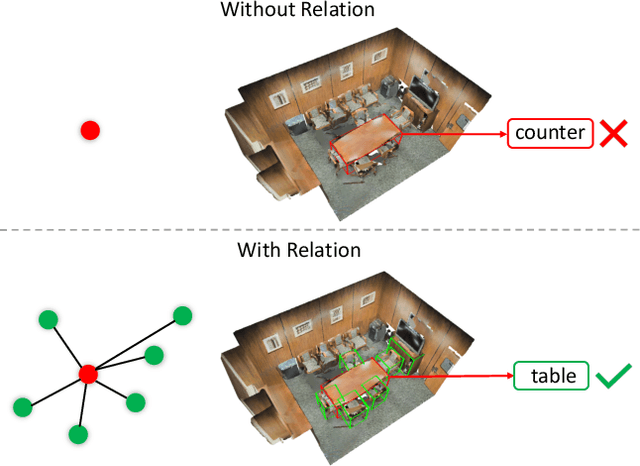
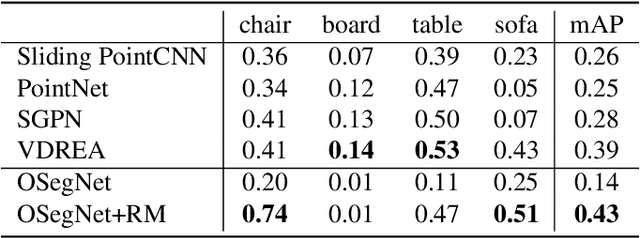

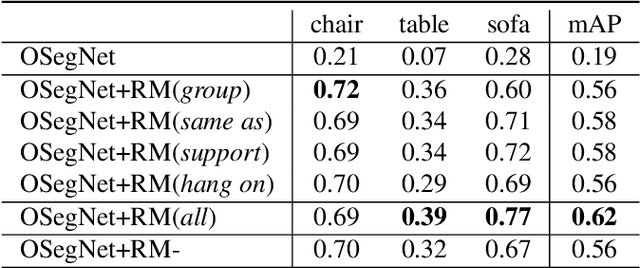
Abstract:Context has proven to be one of the most important factors in object layout reasoning for 3D scene understanding. Existing deep contextual models either learn holistic features for context encoding or rely on pre-defined scene templates for context modeling. We argue that scene understanding benefits from object relation reasoning, which is capable of mitigating the ambiguity of 3D object detections and thus helps locate and classify the 3D objects more accurately and robustly. To achieve this, we propose a novel 3D relation module (3DRM) which reasons about object relations at pair-wise levels. The 3DRM predicts the semantic and spatial relationships between objects and extracts the object-wise relation features. We demonstrate the effects of 3DRM by plugging it into proposal-based and voting-based 3D object detection pipelines, respectively. Extensive evaluations show the effectiveness and generalization of 3DRM on 3D object detection. Our source code is available at https://github.com/lanlan96/3DRM.
* 13 pages, 8 figures
ARM3D: Attention-based relation module for indoor 3D object detection
Feb 20, 2022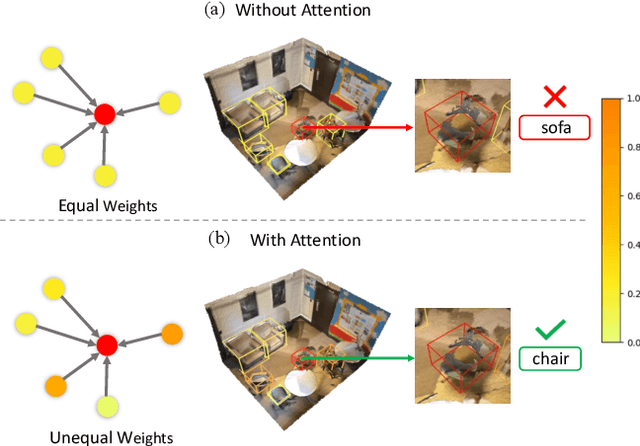


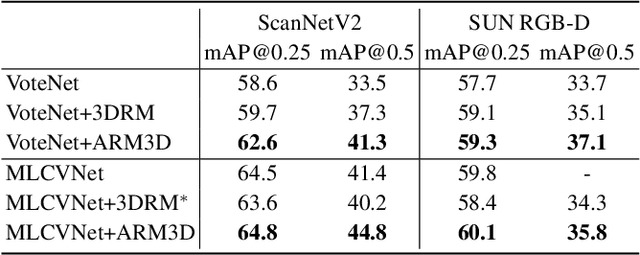
Abstract:Relation context has been proved to be useful for many challenging vision tasks. In the field of 3D object detection, previous methods have been taking the advantage of context encoding, graph embedding, or explicit relation reasoning to extract relation context. However, there exists inevitably redundant relation context due to noisy or low-quality proposals. In fact, invalid relation context usually indicates underlying scene misunderstanding and ambiguity, which may, on the contrary, reduce the performance in complex scenes. Inspired by recent attention mechanism like Transformer, we propose a novel 3D attention-based relation module (ARM3D). It encompasses object-aware relation reasoning to extract pair-wise relation contexts among qualified proposals and an attention module to distribute attention weights towards different relation contexts. In this way, ARM3D can take full advantage of the useful relation context and filter those less relevant or even confusing contexts, which mitigates the ambiguity in detection. We have evaluated the effectiveness of ARM3D by plugging it into several state-of-the-art 3D object detectors and showing more accurate and robust detection results. Extensive experiments show the capability and generalization of ARM3D on 3D object detection. Our source code is available at https://github.com/lanlan96/ARM3D.
RIM-Net: Recursive Implicit Fields for Unsupervised Learning of Hierarchical Shape Structures
Jan 30, 2022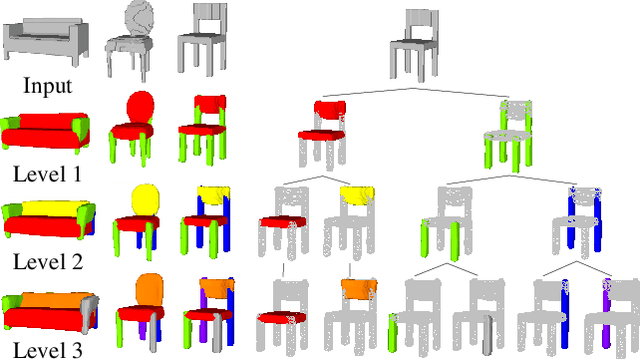
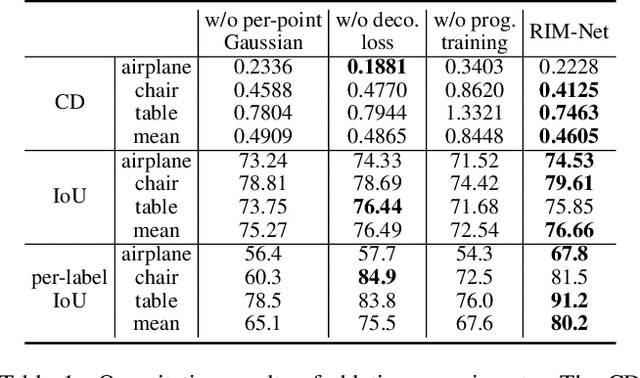


Abstract:We introduce RIM-Net, a neural network which learns recursive implicit fields for unsupervised inference of hierarchical shape structures. Our network recursively decomposes an input 3D shape into two parts, resulting in a binary tree hierarchy. Each level of the tree corresponds to an assembly of shape parts, represented as implicit functions, to reconstruct the input shape. At each node of the tree, simultaneous feature decoding and shape decomposition are carried out by their respective feature and part decoders, with weight sharing across the same hierarchy level. As an implicit field decoder, the part decoder is designed to decompose a sub-shape, via a two-way branched reconstruction, where each branch predicts a set of parameters defining a Gaussian to serve as a local point distribution for shape reconstruction. With reconstruction losses accounted for at each hierarchy level and a decomposition loss at each node, our network training does not require any ground-truth segmentations, let alone hierarchies. Through extensive experiments and comparisons to state-of-the-art alternatives, we demonstrate the quality, consistency, and interpretability of hierarchical structural inference by RIM-Net.
STEdge: Self-training Edge Detection with Multi-layer Teaching and Regularization
Jan 13, 2022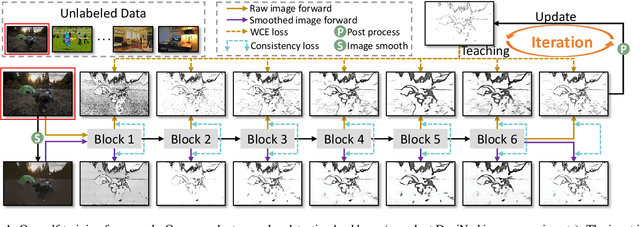
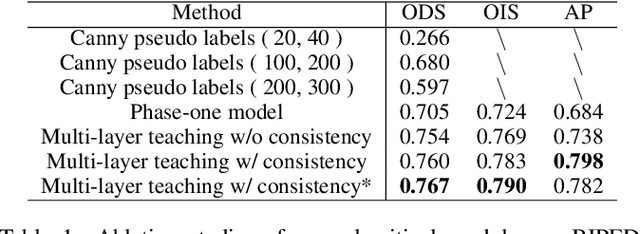
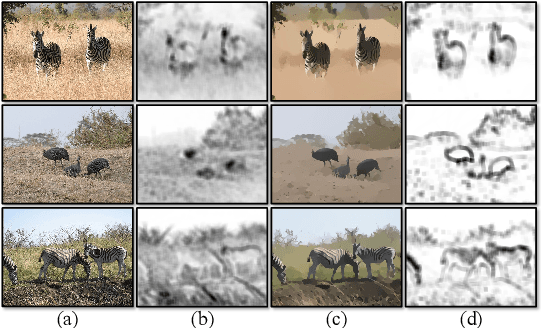
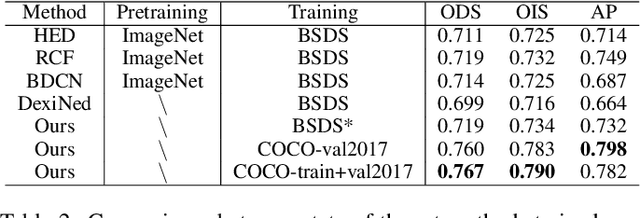
Abstract:Learning-based edge detection has hereunto been strongly supervised with pixel-wise annotations which are tedious to obtain manually. We study the problem of self-training edge detection, leveraging the untapped wealth of large-scale unlabeled image datasets. We design a self-supervised framework with multi-layer regularization and self-teaching. In particular, we impose a consistency regularization which enforces the outputs from each of the multiple layers to be consistent for the input image and its perturbed counterpart. We adopt L0-smoothing as the 'perturbation' to encourage edge prediction lying on salient boundaries following the cluster assumption in self-supervised learning. Meanwhile, the network is trained with multi-layer supervision by pseudo labels which are initialized with Canny edges and then iteratively refined by the network as the training proceeds. The regularization and self-teaching together attain a good balance of precision and recall, leading to a significant performance boost over supervised methods, with lightweight refinement on the target dataset. Furthermore, our method demonstrates strong cross-dataset generality. For example, it attains 4.8% improvement for ODS and 5.8% for OIS when tested on the unseen BIPED dataset, compared to the state-of-the-art methods.
Box2Seg: Learning Semantics of 3D Point Clouds with Box-Level Supervision
Jan 09, 2022

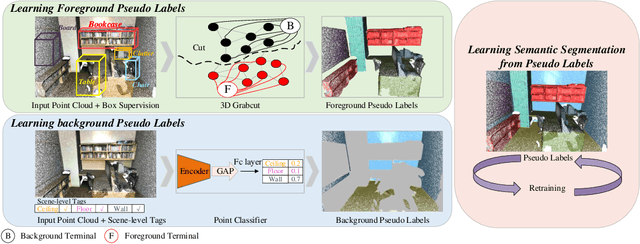

Abstract:Learning dense point-wise semantics from unstructured 3D point clouds with fewer labels, although a realistic problem, has been under-explored in literature. While existing weakly supervised methods can effectively learn semantics with only a small fraction of point-level annotations, we find that the vanilla bounding box-level annotation is also informative for semantic segmentation of large-scale 3D point clouds. In this paper, we introduce a neural architecture, termed Box2Seg, to learn point-level semantics of 3D point clouds with bounding box-level supervision. The key to our approach is to generate accurate pseudo labels by exploring the geometric and topological structure inside and outside each bounding box. Specifically, an attention-based self-training (AST) technique and Point Class Activation Mapping (PCAM) are utilized to estimate pseudo-labels. The network is further trained and refined with pseudo labels. Experiments on two large-scale benchmarks including S3DIS and ScanNet demonstrate the competitive performance of the proposed method. In particular, the proposed network can be trained with cheap, or even off-the-shelf bounding box-level annotations and subcloud-level tags.
Decoupling Makes Weakly Supervised Local Feature Better
Jan 08, 2022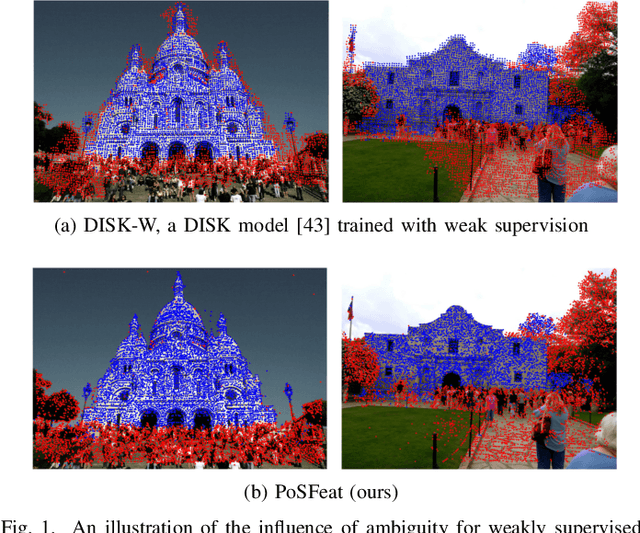
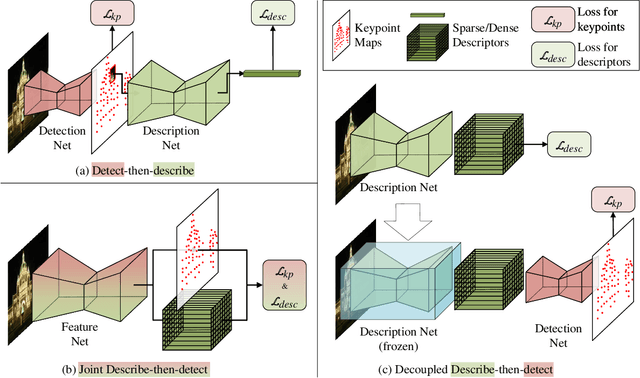
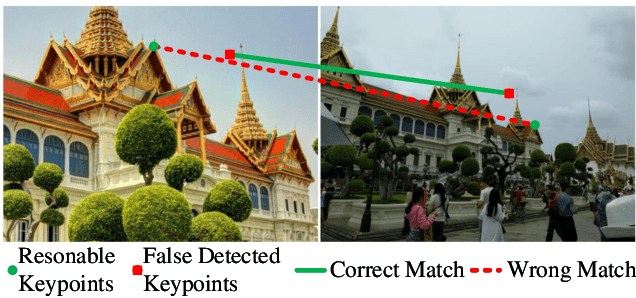

Abstract:Weakly supervised learning can help local feature methods to overcome the obstacle of acquiring a large-scale dataset with densely labeled correspondences. However, since weak supervision cannot distinguish the losses caused by the detection and description steps, directly conducting weakly supervised learning within a joint describe-then-detect pipeline suffers limited performance. In this paper, we propose a decoupled describe-then-detect pipeline tailored for weakly supervised local feature learning. Within our pipeline, the detection step is decoupled from the description step and postponed until discriminative and robust descriptors are learned. In addition, we introduce a line-to-window search strategy to explicitly use the camera pose information for better descriptor learning. Extensive experiments show that our method, namely PoSFeat (Camera Pose Supervised Feature), outperforms previous fully and weakly supervised methods and achieves state-of-the-art performance on a wide range of downstream tasks.
 Add to Chrome
Add to Chrome Add to Firefox
Add to Firefox Add to Edge
Add to Edge